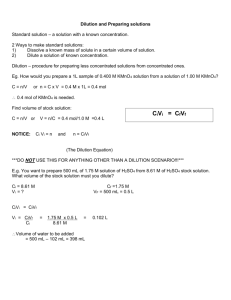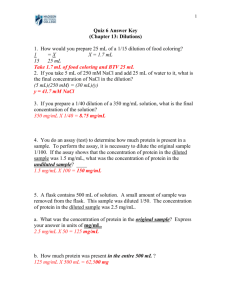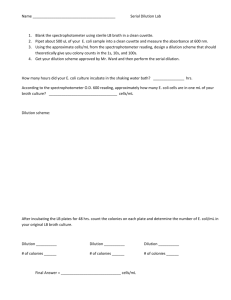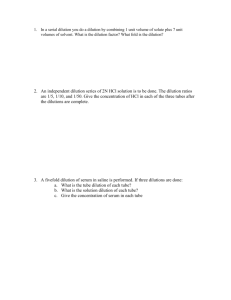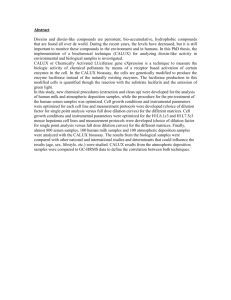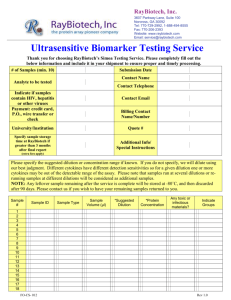1 Practice Dilution Problems For The Bio 201 Practical
advertisement
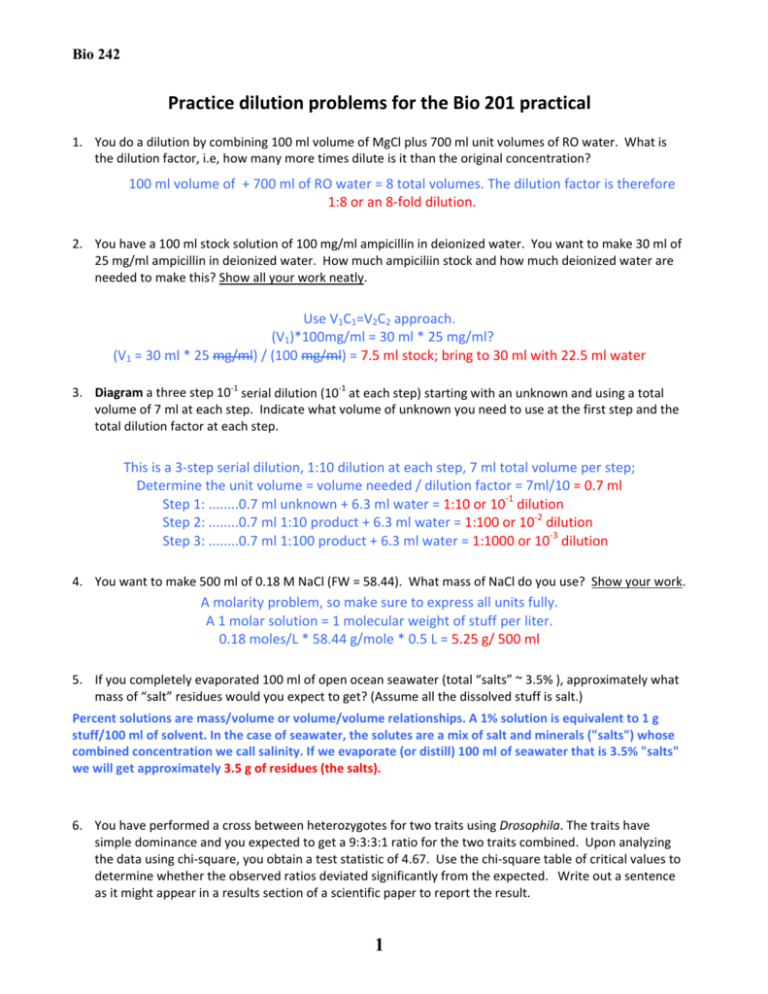
Bio 242 Practice dilution problems for the Bio 201 practical 1. You do a dilution by combining 100 ml volume of MgCl plus 700 ml unit volumes of RO water. What is the dilution factor, i.e, how many more times dilute is it than the original concentration? 100 ml volume of + 700 ml of RO water = 8 total volumes. The dilution factor is therefore 1:8 or an 8‐fold dilution. 2. You have a 100 ml stock solution of 100 mg/ml ampicillin in deionized water. You want to make 30 ml of 25 mg/ml ampicillin in deionized water. How much ampiciliin stock and how much deionized water are needed to make this? Show all your work neatly. Use V1C1=V2C2 approach. (V1)*100mg/ml = 30 ml * 25 mg/ml? (V1 = 30 ml * 25 mg/ml) / (100 mg/ml) = 7.5 ml stock; bring to 30 ml with 22.5 ml water 3. Diagram a three step 10‐1 serial dilution (10‐1 at each step) starting with an unknown and using a total volume of 7 ml at each step. Indicate what volume of unknown you need to use at the first step and the total dilution factor at each step. This is a 3‐step serial dilution, 1:10 dilution at each step, 7 ml total volume per step; Determine the unit volume = volume needed / dilution factor = 7ml/10 = 0.7 ml Step 1: ........0.7 ml unknown + 6.3 ml water = 1:10 or 10‐1 dilution Step 2: ........0.7 ml 1:10 product + 6.3 ml water = 1:100 or 10‐2 dilution Step 3: ........0.7 ml 1:100 product + 6.3 ml water = 1:1000 or 10‐3 dilution 4. You want to make 500 ml of 0.18 M NaCl (FW = 58.44). What mass of NaCl do you use? Show your work. A molarity problem, so make sure to express all units fully. A 1 molar solution = 1 molecular weight of stuff per liter. 0.18 moles/L * 58.44 g/mole * 0.5 L = 5.25 g/ 500 ml 5. If you completely evaporated 100 ml of open ocean seawater (total “salts” ~ 3.5% ), approximately what mass of “salt” residues would you expect to get? (Assume all the dissolved stuff is salt.) Percent solutions are mass/volume or volume/volume relationships. A 1% solution is equivalent to 1 g stuff/100 ml of solvent. In the case of seawater, the solutes are a mix of salt and minerals ("salts") whose combined concentration we call salinity. If we evaporate (or distill) 100 ml of seawater that is 3.5% "salts" we will get approximately 3.5 g of residues (the salts). 6. You have performed a cross between heterozygotes for two traits using Drosophila. The traits have simple dominance and you expected to get a 9:3:3:1 ratio for the two traits combined. Upon analyzing the data using chi‐square, you obtain a test statistic of 4.67. Use the chi‐square table of critical values to determine whether the observed ratios deviated significantly from the expected. Write out a sentence as it might appear in a results section of a scientific paper to report the result. 1 Bio 242 Chi‐square problem; Four phenotypic classes so df = 4‐1 = 3, critical value at df = 3 and p (or ) = 0.05 = 7.8. Since the test statistic (4.67) < critical value (7.8), we do not reject the NULL, i.e., the observed frequencies agreed with a 9:3:3:1 ratio. A plausible results sentence: "The distribution of F2 phenotypes indicated that two genes were involved and that they appear to assort independently." Note that no stat summary needs to be included since there was not a significant difference. 7. Table 1. Mean mass of BalbC mice fed high protein ration over 20 days. The same mass of food was provided to each mouse each day, and all food was consumed at each feeding. Group Ration‐Type Mean mass at start (g SD1 (n) ) Mean mass at end (g SD (n) ) control Standard formula 45.4 5.3 (50) 59.2 3.6 (50) treatment High protein formula 46.1 5.0 (50) 65.7 3.2 (50) 1 Read the error term as SD not SEM (we haven't used SEM so you wouldn't know how to deal with it ‐ mia culpa!!) a. You are trapped on a desert island without palm pilot or calculator. Your life depends on a correct interpretation of the results in Table 1. Do you believe that there was a significant change in mean mass due to the high protein diet? Defend your answer. If we adhere strictly to our stranded‐on‐a‐desert island rubric for deciding significance, i.e., is there overlap in the range of the SD's, we must say that the difference isn't significant because the SD's overlap by about 0.3. However, because we have a large sample size (n =50 for each group), and because the overlap is very small, we, as thinking and rational biologists, are more inclined to believe that the difference in the means is really significant. If only we had a computer..... Mass (g) SD 75 50 25 0 Standard High Protein Diet b. Miracle of miracles, you find a portable PC washed up on shore and it works. Not only that, but it has statistical software on it (it belonged to a biogeek). Which statistical test would you employ to determine the significance of the difference in mean masses? Oh joy! Look what washed up on shore! A Dell PC! Still runs great though! Now we can run that unpaired t‐test! 8. Standard curve: either plug the absorbance value (Y) into the regression and solve for X; OR map the absorbance to the x‐axis via the regression line. Around 17.1 ug/fly. 2


